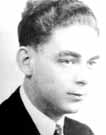
|
|
|

|

|

|

|
|
Click on an image to see a larger, more detailed picture.
|
|
|
|
|
| 1943: Death and Resistance |

|
pg. 441 |

|
|
|
|
| |
 Over 75 percent of Dutch Jews were deported to Auschwitz, Sobibór, and other death camps. Few survived. Some Dutch citizens struggled to thwart the massive Nazi effort to exterminate the country's Jews. Several conspirators, including C. Hartogh, plotted the destruction to impede the Nazis' deportation plans. Hartogh was executed a few months later.
Over 75 percent of Dutch Jews were deported to Auschwitz, Sobibór, and other death camps. Few survived. Some Dutch citizens struggled to thwart the massive Nazi effort to exterminate the country's Jews. Several conspirators, including C. Hartogh, plotted the destruction to impede the Nazis' deportation plans. Hartogh was executed a few months later.
Photo: Verzetsmuseum Amsterdam / United States Holocaust Memorial Museum Photo Archive
|
 Acts of Dutch resistance included the bombing of the Amsterdam population registry on March 27, 1943.
Acts of Dutch resistance included the bombing of the Amsterdam population registry on March 27, 1943.
Photo: Verzetsmuseum Amsterdam / United States Holocaust Memorial Museum Photo Archive
|
 The concentration camps provided Nazi doctors with a large pool of human guinea pigs for their "experiments," many of which had specifically military objectives. This man was the victim of an air-pressure experiment at the Dachau, Germany, concentration camp, the goal of which was to measure human endurance at extremely high altitudes. In the course of the experiment, the man was placed in a pressure chamber from which air was slowly removed. Thus, Nazi "scientists" could determine how high their pilots could safely fly.
The concentration camps provided Nazi doctors with a large pool of human guinea pigs for their "experiments," many of which had specifically military objectives. This man was the victim of an air-pressure experiment at the Dachau, Germany, concentration camp, the goal of which was to measure human endurance at extremely high altitudes. In the course of the experiment, the man was placed in a pressure chamber from which air was slowly removed. Thus, Nazi "scientists" could determine how high their pilots could safely fly.
Photo: Yad Vashem Archives
|
|

|

|

|

|
 April 1943: Pope Pius XII complains that Jews are demanding and ungrateful.
April 1943: Pope Pius XII complains that Jews are demanding and ungrateful.
|
 April 1943: Dr. Julian Chorazycki, a former captain in the Polish Army and a leader of inmate resistance at the Treblinka death camp, takes poison when the camp's deputy commandant spies currency Chorazycki had planned to use to buy small arms; See May 3, 1943.
April 1943: Dr. Julian Chorazycki, a former captain in the Polish Army and a leader of inmate resistance at the Treblinka death camp, takes poison when the camp's deputy commandant spies currency Chorazycki had planned to use to buy small arms; See May 3, 1943.
|
 April 5, 1943: Three hundred Jews from Soly and Smorgon, Belorussia, are transported by rail westward to Vilna, Lithuania. En route, the captives shatter the railcars' wire-reinforced glass and attempt to flee, but are shot to death by guards. The survivors are later shot at Ponary, southwest of Vilna, by German and Lithuanian SS troops. About 4000 Jews from in and around Vilna are trucked to Ponary, slaughtered, and dumped into mass graves. Jews arriving at the Ponary station by rail from Oszmiana and Swieciany, Lithuania, resist with revolvers, knives, and their bare hands; a few dozen escape to Vilna and the rest are shot. During the massacre, a Lithuanian policeman is wounded by Jews and an SS sergeant is hospitalized after being stabbed in the back and in the head.
April 5, 1943: Three hundred Jews from Soly and Smorgon, Belorussia, are transported by rail westward to Vilna, Lithuania. En route, the captives shatter the railcars' wire-reinforced glass and attempt to flee, but are shot to death by guards. The survivors are later shot at Ponary, southwest of Vilna, by German and Lithuanian SS troops. About 4000 Jews from in and around Vilna are trucked to Ponary, slaughtered, and dumped into mass graves. Jews arriving at the Ponary station by rail from Oszmiana and Swieciany, Lithuania, resist with revolvers, knives, and their bare hands; a few dozen escape to Vilna and the rest are shot. During the massacre, a Lithuanian policeman is wounded by Jews and an SS sergeant is hospitalized after being stabbed in the back and in the head.
|
|
|
|
|
| 1943: Death and Resistance |

|
pg. 441 |

|
|
The Holocaust Chronicle
© 2009 Publications International, Ltd.
|
|
